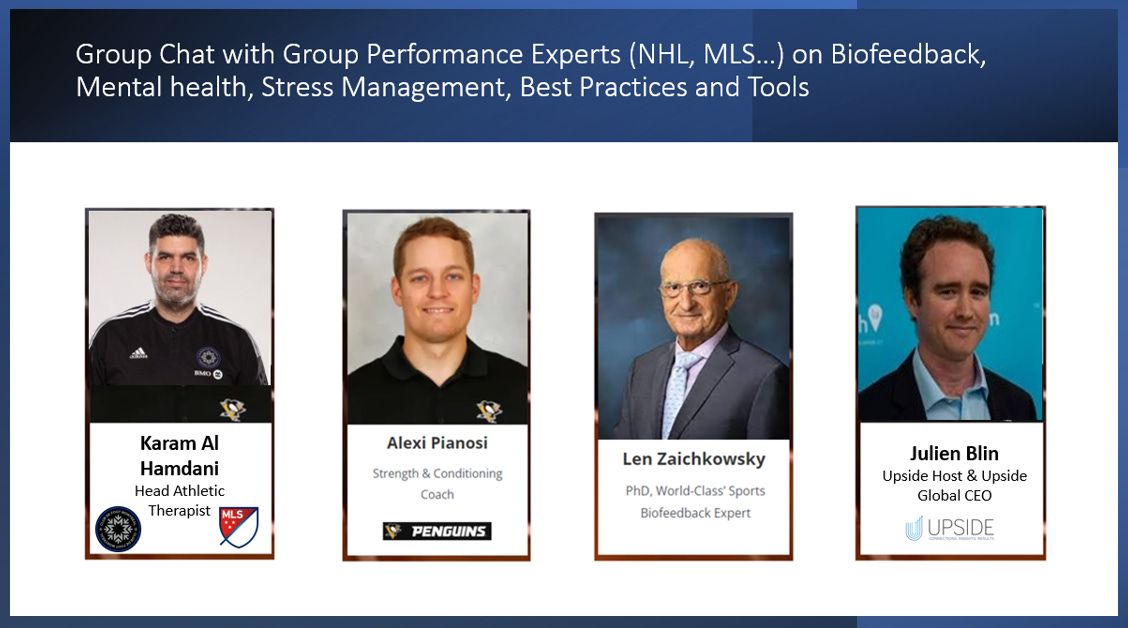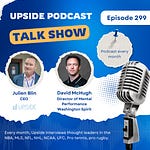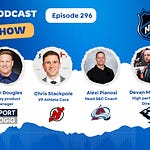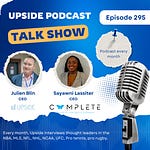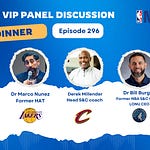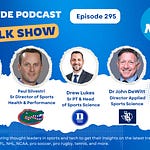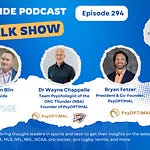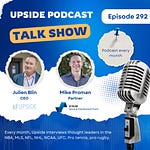This week we had the honor to interview again a group of sports performance experts.
Alexi Pianosi, S&C coach for the Pittsburgh Penguins, a top NHL team.
Len Zaichkowsky, PhD, also known as Doc Z, an experienced biofeedback expert (NHL, NBA, Laliga..). Len is a retired Professor from Boston University and performance consultant who has worked with many elite pro teams (Vancouver Canucks (NHL), Penguins (NHL), Real Madrid, National Spanish soccer team…) over the years.
Karam Al-Hamdani, the Head Athletic Therapist for the CF Montreal, a top MLS team.
📝Show Notes: Through this interview, we touched on the best practices and tools that they have come across regarding stress management, mental health, and biofeedback. We also touched on the current adoption of biofeedback in the MLS and NHL. They also shared some stories of athletes where biofeedback really helped them. Then we discussed how they think the biofeedback / stress management space are going to evolve in the next five years.
🚀Best Quotes: Here are some of the key discussion points and best quotes from our conversation with Alexi, Len, Karam:
On the definition of stress management, mental health, and the best tools that they have used:
Len Zaichkowsky:
“There's stress everywhere, both from a performance standpoint, family and friends and management and contracts standpoint. Stress is all over the place. But we have to learn how to combat it”.
“I've learned over the years in working in high performance sport that most athletes are at the high end physically, and generally they're outstanding cognitively”.
“Perceived stress is the precursor to mental health which is dysfunctional, particularly for high-end athletes. So we want to minimize that and getting that right balance between the parasympathetic nervous system and the sympathetic nervous system, that's where biofeedback training is going to come in”.
“I like using the term cognitive fitness, just like we have the term physical fitness. We've got some wonderful studies going on between here and Australia where they are trying to develop that concept. And you mentioned the term mental breakdown”.
Karam Al-Hamdani:
“I believe that this topic is still at its beginning phase. I feel like there are a lot of teams out there that are not exercising the full potential of what all this stuff can bring to an organization, and I think that it's because of this stigma that's associated with it, which really sucks”.
“So my job as a head athletic trainer, as well as the strength coach’s job is to sort of hack away at that stigma and start coaching and educating these players that it's okay to be stressed. It's okay to go through periods of up, down, up, down, and recognizing these periods and recognizing that it's okay to be in a down period, because what goes down has to come back up and vice versa”.
“And what's also important is to coach them on not having valleys in between the ups and the downs and trying to maintain this speed bumps”.
“We have hired a sports psychologist. And what's interesting with him is that he actually played at the professional level. He played professional football and then he was also able to get his schooling done. He did a degree in kinesiology to start off with, and then topped it off with a master's in sports psychology”.
“In the last couple of years, sports psychology in the MLS really took off.
And it's unfortunate that I have to say this but the biggest catalyst to create this boom was COVID because you had players in quarantine for days and days and days (..) And they just didn't know what to do with themselves”.
Alexi Pianosi:
“As Len also alluded to, the ups and downs of playing professional sports comes within a lot of stress. And us as practitioners, whether it's therapists or strength coaches, I think we're there to assist with that process and help players handle adversity and help players handle good games and bad games when the coach is happy or unhappy”.
“And I think helping them train that mental resiliency or that mental system or the mental fitness Len likes to call it, I think is somewhere we can be very impactful”.
On the definition of biofeedback, and the best tools that they have used:
Alexi Pianosi:
“I think biofeedback has a tremendous potential and tremendous power. I've found it much easier to implement or tackle in an individual setting with one player that you might have for an extended period of time”.
Maybe it's a longer return to play scenario, maybe it's an off season project, something like that where you can converse with them a little bit more, a little bit more feedback after each session, during each session, honing in the practices, maybe the amount of time, the technique, the device, things like that. But is is much more difficult on a larger, more global scale, at least in my opinion”.
“So I think if you can maybe start granular and find one player, or two players, maybe you can build up some steam and then trickle it into a larger effect with the team. But I've definitely found more success personally in smaller individual settings in the larger team setting”.
“We've used HRV for a number of years now and I have to give a lot of credit to one of my predecessors, Andy O'Brien, for kickstarting that process in Pittsburgh. But we've found it to be a very good bridge between the sport science performance department and our coaching staff. They always want to know how are the player's doing. Are they recovered? How are they feeling? And the HRV actually was a number that they were able to connect with. And that helped with a little bit of practice planning that helps a little bit of returning from the west coast trips to the east coast, things of that nature”.
“We have found a lot of value with HRV, at least in our team setting. And I think that was coming through around the same time as the research on acute to chronic workload was picking up steam. You're starting to see the delays and wow, we actually feel pretty good when we come off of that road trip, but 2, 3, 4 days later, when we've been fighting a little bit of maybe sympathetic dominance longer than we wish we could have, and we needed to empower that parasympathetic side a little bit”.
“That's when we started to see a little bit more residual fatigue in our team. And now our coaching staff has baked that into their schedule automatically, and they don't really need us to tell them, there might be one or two times throughout the year when we pick up on something that they didn't already plan for or were prepared for”.
Len Zaichkowsky:
“Since I've spent most of my life working in that field, I got into the biofeedback field when I was first got to Boston University and that field was just emerging and many of you guys in the therapy world started with EMG and the great John Basmajian who developed single motor unit training. He basically showed people how you could train single motor units in muscle if you gave them feedback”.
“And that was kind of first step in the development of this field called biofeedback, which ultimately led into to stress and stress management. But there are other modalities, such as heart rate, and then more recently the evolution of heart rate variability, and respiration rate teaching people how to breathe properly.
“Skin conductance was the other modality where sweat response was measured and then more recently the neuro system or the brain, which sometimes is not called biofeedback. Rather it's called neurofeedback. It's the same thing”.
“So these modalities needed technology, and when I started this business, it was in the early seventies. I wanted to bring Biofeedback to sport because I saw the world of sport full of stress and it need needed technological support to help athletes manage it and coaches to manage it. But the equipment back in those days, the size of my office, it was expensive. And now we've gone to the point of miniature devices, a fantastic evolution in that field”.
“So what is biofeedback? It's about putting sensors on the human body that allows us to pick up muscle information, sweat response, temperature response, neural responses, HR and then feed it back to the person. And if you get feedback about something and you get practice, you're going to get better at it. We've learned how to teach athletes and ordinary people to self-regulate their body's responses, but you can't master that unless you get some kind of feedback. So that's what I define biofeedback, although it certainly has grown beyond that”.
Karam Al-Hamdani:
“The only thing that I can expand on, to be honest with you, is what I am currently pushing for, because I've recognized it, the true potential of it, and it's heart rate variability, as a form of biofeedback”.
“The best way that I can do so is try to find a way to correlate heart rate variability with injury incidents and the increase or decrease of injury incidents based on that type of biofeedback. But I'm still at the starting stages of it, even though I've had an Oura ring for the last two years, so I'm still studying it myself”.
If biofeedback and stress management have become a common practice in the world of sports:
Len Zaichkowsky:
“The biggest project I helped on was with my good friend in Europe, Walter DeSalvo, who was with Real Madrid when I first met him. And then he went over to Qatar and he was there as their football sports scientist and they developed an incredible facility. We didn't call it biofeedback”.
“It was kind of psychophysiology, which is the same thing, a little fancier word, but it was an optimal training station where they learned to self-regulate their biological processes to get parasympathetic and sympathetic systems in regulation”.
“And then they could transfer that training to a small pitch and ultimately to the big pitch. Can you manage those stressors from what you learned in the lab to the small pitch to the big pitch? And it was a wonderful progression, but they have the money to do that. Most sports organizations don't have that kind of funding to do that, but that's the real world that I experienced where it can be done, but it can be expensive too”.
“I think the younger, sharper individuals within pro teams do see the benefits. Prices for the technology have really come down too, and that's making that a little bit easier. They don't see it as a major investment anymore”.
“The little budget teams may not be able to afford 30 Oura rings, but they can do things like apps on your Android or Apple iPhone. They can start with that. Most of the things are inexpensive or maybe even free. You can teach heart rate, self-regulation, respiration. You don't need a thousand dollars piece of equipment. It's right on your phone with these apps”.
Karam Al-Hamdani:
“I echo Len's words that there's an uphill road to cross in education and educating these GMs, coaches who themselves were former players in an era where none of this existed. So for them it's like a new bell or a new whistle, and you're trying to suffocate them with all this information. Some of them just can't handle too much information, so it's all about educating them. and then secondly, in the MLS I would say maybe 25% of the teams use biofeedback, but that's a rough guess”.
“I know for a fact that Orlando City SC is using biofeedback. LAFC is also using biofeedback. If I were a guessing man, it would just be by the nature of who they're partnered up with. Seattle are for sure using biofeedback because of their co their coexistence with Microsoft which is based out of Seattle, right? I would also think that Vancouver is big on biofeedback too, and the important thing to highlight here is the teams that I mentioned are teams that have big budgets. They can afford buying let’s say 30 Oura rings and the platform that goes with it, which is bout 40 grand right there per year”.
Alexi Pianosi:
“In the NHL, probably almost all NHL teams have at least one player wearing an Oura ring, but are they actually using that data? Are they using it on a team wide basis? Are they even using it with that one athlete in a consistent, productive way? We have probably five or six people using it”.
“The number of people in the NHL who are consistently using or implementing a biofeedback device or system is probably pretty low, I would think. I would guess that it is even less than 30%. But the number of people who are experimenting with it and trying to learn more about it and trying to add it or to their current regime, I think that's probably pretty high”.
On stories of athletes they could share where biofeedback really helped some athletes:
Len Zaichkowsky:
“I had an NHL player now retired who was in Vancouver. He jumped all over that whole idea of training the heart rate and respiration to be in sync and that he could bring at will his values down post-game because you players are exhausted after a tough game and first thing he did was to run into my facility and get on the relaxation, hook him up to respiration and heart rate and in just a 10 minute protocol”.
“He sweared that it benefited him immensely long after he retired. He'd call me probably once a year and say how it transformed, you know his career, but also his life”.
Alexi Pianosi:
“Some guys would tell me “I don't want to know my HRV score, don't tell me. they don't want to know that their HIV is up or down on a game day or practice day. They just want to go up there and play. and that's obviously totally fine. However each player wants to do it. But the players who could handle that information and digest it and that they can still play their best game tonight, regardless of what that number says”.
“Some of them got pretty in tuned with it. And I can think of an athlete. For him it was almost a fun game. He would come and he'd do it and he guess what his HRV score was and he was remarkably close every time. So it almost got, it almost got to the point where it defeated the purpose”.
Karam Al-Hamdani:
“The only story that stands out to me before this whole COVID thing. We had one player that was doing his rehab with us. He was injured and we had a tendency to check his heart rate variability just so that we could establish how hard, were we going to push that day in the rehab? And for the most part, his HRV was pretty constant. And then he comes in one day and we checked his HRV and it was super low that morning. And we're like, is everything okay? Is everything good at home? What's going on?”.
“He's like, Nothing. I’m perfectly fine. I had a good night's sleep. Everything is good. We're like, okay, well listen, we're gonna take it easy today”.
“And then it was probably around 5-5 30 pm. He's like, I'm sick as a dog. So he woke up. He feels like an 18 wheeler hit him and for four or five days after that he had the flu, but his HRV was able to patch onto it the morning before it happened, so we were able to sort of tone things down and not crash and send him to levels where he's crashing and burning. And then on top of that, You don't get sick. So that was a story that really sort of stuck with me”.
On how they think the biofeedback / stress management space are going to evolve in the next five years:
Len Zaichkowsky:
“My sense is that the technology is driving so much of everything already. And it's going to continue to improve. It's going to get cheaper and better. And this is going to go cross disciplines between the physios and the coaching staff and the psychologists, it will be cross crossing disciplines and nobody will necessarily have to have ownership of that knowledge base, but it will all be there to enhance the performance of the athletes”.
“So that's the direction I hope things go and not have subgroups kind of claiming ownership'“.
Alexi Pianosi:
“There's going to be a bit of a gap I think between the technology and the realistic nature of the scheduling and the people that are implementing and feeding technology. So I don't know where the future goes, but I think if you look backwards, some of the much more basic stuff with just some breathing and understanding the autonomic nervous system like Len was doing probably 10, 20 years ago, is still really good quality stuff that could be done”.
“And it doesn't need a lot of technology. It's very simple. You need to buy in and you need the understanding, and you need to have a really good action plan for implementing it. So as much as technology is likely to lead us, because that just seems what is happening in 2023 and beyond, I think you can still look backwards and take a step forward in how you implement some of the things we learned 10, 20 years ago”.
Karam Al-Hamdani:
“I believe that it's trending upwards. I believe that it's starting to make its place in the continuum of high performance and sports medicine, just like when 10 years ago nobody used to wear a GPS unit. Nowadays it's starting to become the norm. If you're a team that doesn't have GPS, you're the odd man out”.
“So I feel like in a couple of years, this is going to be something that's going to be standard in sports organizations and it takes people like Len (Doc Z), like Alexi and, and like me to sort of help propel all of this and show the value of all these types of technologies moving forward so that it gets adopted throughout the leagues”.
You may also like:
🔥Upside Chat: Len Zaichkowsky, World-Class’ Sports Biofeedback Expert
⭐🧠 Upside Analysis: This is Sports' Secret Sauce.
🔥Upside Chat: Alexi Pianosi, Strengths and Conditioning Coach, Pittsburgh Penguins (NHL)
🔥Upside Chat: Pierre Barrieu, High Performance Director, Toronto FC (MLS)
🔮 2022 Upside Top Sports Tech Predictions (NFT/Metaverse, Sports Performance, IPOs/M&As..)


